As a loving pet parent, you want to ensure your canine companion lives a long, healthy, and happy life. Part of that commitment involves being mindful of what they eat. While some human foods can be a delightful and nutritious addition to your dog’s diet, others can be downright dangerous, even toxic, in small amounts. The line between safe and unsafe can be blurry, leading to confusion and, unfortunately, preventable pet poisonings. In fact, over 401,500 pet poisonings occur annually in the United States, with common household foods being a significant contributor. Understanding what food dogs cannot eat is crucial for safeguarding your furry friend.
This comprehensive guide aims to be your essential resource, clarifying which human foods are off-limits and which can be enjoyed safely. We’ll delve into why certain foods pose a threat, list common toxic items, and also provide a helpful overview of safe options. By staying informed, you can prevent accidental ingestion and confidently nourish your dog. For more insights on what human foods your dog can safely enjoy, read our article on what fresh food can i feed my dog.
Why Certain Foods Are Toxic to Dogs
The question of “what food dogs cannot eat” often stems from fundamental differences in canine and human digestion and metabolism. Dogs’ bodies process certain substances in unique ways, making many foods that are harmless to us potentially hazardous for them.
A prime example is chocolate, which contains theobromine and caffeine. Dogs metabolize these compounds much slower than humans, allowing them to accumulate rapidly in their system and potentially reach fatal levels. Similarly, while you might enjoy cherries, the cyanide found in their pits, stems, and leaves can be problematic for dogs if consumed in large quantities. Cherry pits can also cause digestive upset and blockages, making it best to avoid them altogether.
Food toxicity can also be influenced by factors such as a dog’s size, breed, and overall health. A small dog, for instance, will be more severely affected by a small amount of a toxic substance than a large dog. Therefore, if you ever have doubts about specific items your dog shouldn’t eat, consulting your veterinarian is always the safest course of action.
List of Common Foods Dogs Cannot Eat
Many everyday household foods are dangerous, and often toxic, to dogs. This list details some of the most common foods that are bad for dogs. While extensive, please remember this is not an all-inclusive compilation.
1. Alcohol
Due to their smaller size, alcohol has a much more potent and potentially deadly effect on dogs than on humans. Even minimal amounts can cause harm, with smaller pets being at higher risk. Symptoms of alcohol poisoning in dogs mirror those in humans, including vomiting, breathing difficulties, coma, and even death.
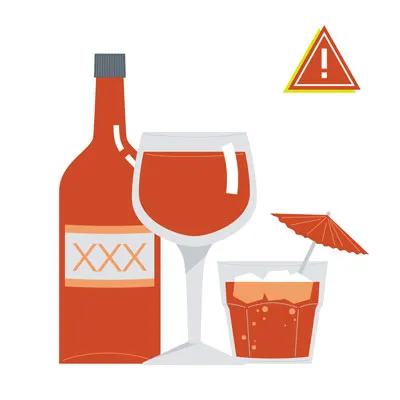 A close-up shot of a glass of amber-colored alcoholic beverage
A close-up shot of a glass of amber-colored alcoholic beverage
2. Apple, Apricot, Cherry, and Plum Seeds/Pits
While the fleshy part of apples is generally safe for dogs, the core and seeds are not. Apple seeds contain cyanide, and though small amounts might be tolerated, it’s best to remove the core and seeds entirely. Similarly, the seeds and pits of apricots, cherries, peaches, and plums should be avoided. These also contain cyanide, which can lead to vomiting, an irregular and rapid heartbeat, seizures, coma, and even death by impairing red blood cells’ ability to carry oxygen.
3. Avocado
Avocados are not a suitable food choice for dogs. While the exact toxic mechanism isn’t fully understood in dogs, there have been reported cases of myocardial damage in dogs after avocado consumption. Additionally, an intact avocado pit poses a significant choking hazard and can obstruct a dog’s gastrointestinal tract. It is safest to keep this fruit away from your canine companion.
4. Broccoli
Broccoli contains isothiocyanates, which can be harmful to pets in very large doses. Although small, occasional servings of broccoli might be okay, it’s generally best to avoid it when so many other healthy and safe vegetable options are available for dogs. The stalks of broccoli can also pose a choking risk or cause an obstruction in a dog’s throat.
5. Caffeine and Coffee Grounds
Caffeine contains methylxanthines, compounds that can cause potentially fatal symptoms in dogs, including diarrhea, vomiting, seizures, and an irregular heartbeat. Accidental ingestion of coffee grounds or highly caffeinated beverages can cause a dog’s heart to race, leading to tremors, arrhythmia, difficulty breathing, and other severe symptoms.
6. Chicken & Turkey Skin, Ham, and Other Fatty Cuts of Meat
Fatty cuts of meat, including ham, chicken, or turkey skin, are best discarded rather than given to pets as treats. Their high-fat content can trigger acute pancreatitis, a life-threatening illness with serious complications. Furthermore, avoid giving turkey and chicken bones, as they can splinter and cause internal damage or obstructions in the stomach or intestines, potentially leading to fatal abdominal infections.
7. Chocolate
Chocolate toxicity is a frequent cause of pet poisoning, particularly during holidays. Any chocolate product is unequivocally on the list of what food dogs cannot eat. Chocolate contains the lethal compound theobromine, with darker varieties having higher concentrations. It also contains caffeine, and some sugar-free chocolates may even include xylitol, another substance highly toxic to dogs. Dogs and cats simply cannot metabolize chocolate as efficiently as humans. Dark chocolate and baker’s chocolate are the most dangerous, but all types of chocolate pose a risk.
Symptoms of chocolate ingestion include hyperactivity, vomiting, diarrhea, pancreatitis, abnormal heart rhythm, and seizures. If your dog consumes any amount of chocolate, no matter how small, contact your veterinarian immediately.
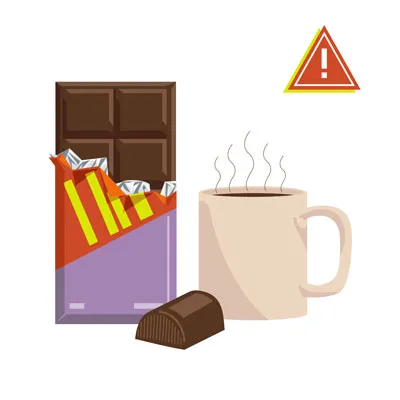 An assortment of dark chocolate pieces and cocoa powder
An assortment of dark chocolate pieces and cocoa powder
8. Grapes and Raisins
Grapes and raisins are exceptionally dangerous for dogs. These fruits contain tartaric acid, which is toxic to a dog’s kidneys and can lead to serious problems like kidney failure. Even a few bites can wreak havoc. Signs of raisin or grape poisoning include vomiting and diarrhea, loss of appetite, changes in urination (either increased or decreased), or a complete inability to urinate.
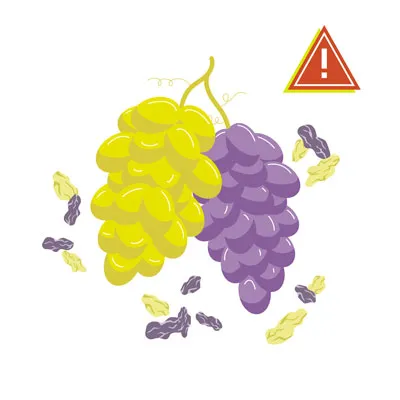 Close-up of red grapes on the vine, glistening slightly
Close-up of red grapes on the vine, glistening slightly
9. Macadamia Nuts, Almonds, and Pistachios
Macadamia nuts can cause a range of painful symptoms in dogs, such as weakness, overheating, and vomiting. While the exact mechanism of toxicity is still somewhat a mystery, these nuts are definitively toxic to dogs, with as few as six nuts capable of causing severe poisoning in a small dog. While macadamia nuts are the most perilous, other nuts like pistachios and almonds can present choking hazards, especially if they are flavored or spiced.
10. Milk and Dairy Products
Milk and other dairy products should be approached with caution. While some dogs tolerate them well, many are lactose intolerant or allergic, experiencing diarrhea and gas after consuming cow’s milk. Ice cream is particularly bad due to its high sugar and fat content. Instead of ice cream, consider offering frozen bites of healthy fruits. Small quantities of lower-fat cheese can be given as an occasional treat, but high-fat varieties should be avoided.
11. Mushrooms
It’s always best to err on the side of caution and avoid feeding your dog any mushrooms. Mushrooms can contain various toxins that may cause kidney and liver failure, vomiting, diarrhea, hallucinations, and damage to red blood cells. While washed, white grocery store mushrooms might theoretically be okay, opting for a different, proven safe treat is the safer choice.
12. Nutmeg and Cinnamon
Nutmeg is a spice that dogs should never consume, as it can cause severe vomiting and hallucinations due to a compound called myristicin. Its effects are more pronounced in high doses or in smaller dogs. If your dog ingests any amount of nutmeg, contact your veterinarian for guidance. Cinnamon, while not toxic, can irritate your dog’s mouth and potentially lead to a dangerous drop in blood sugar levels.
13. Onions, Garlic, Chives, and Leeks
Many pet owners are unaware that herbs belonging to the allium family, such as onions and garlic, are unsafe for dogs. These plants contain sulfoxides and disulfides, which can damage red blood cells and cause anemia in both dogs and cats. Onion and garlic powders are common ingredients in many prepared foods, including baby food, so carefully check labels before offering any store-bought items to your pet. All allium plants, including chives and leeks, can lead to potentially fatal anemia in dogs. Certain Japanese breeds, like Akitas and Shiba Inus, are particularly sensitive, but these plants are dangerous for all dogs.
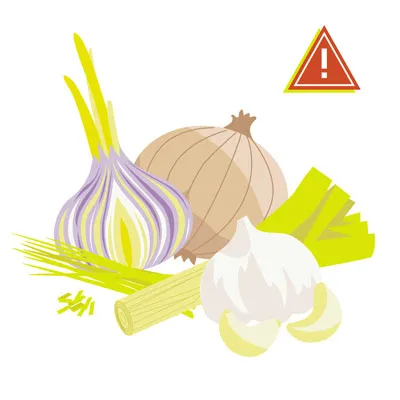 A bunch of red onions, a garlic bulb, and green chives
A bunch of red onions, a garlic bulb, and green chives
14. Salt
Excessive salt intake can disrupt the fluid balance in a dog’s cells, leading to tremors, seizures, diarrhea, or even a coma. Whether it’s rock salt, homemade play dough, or salty potato chips, do not let your dog’s pleading eyes jeopardize their health.
15. Spicy Food
Keep your pup far away from spicy foods. Hot, spicy ingredients can cause vomiting, stomach ulcers, or diarrhea, which can be extremely painful for your dog and potentially lead to costly emergency vet visits.
16. Sugar-Free Gum and Candy (Xylitol)
Xylitol is an artificial sweetener found in numerous human foods, including sugar-free gum, candy, and many baked goods. In dogs, even small amounts of xylitol can cause a rapid and dangerous drop in blood sugar, leading to weakness, seizures, and even liver failure. The incidence of xylitol poisoning in dogs is rising. For example, the amount of xylitol in just five pieces of gum has the potential to be fatal for a 65-pound dog.
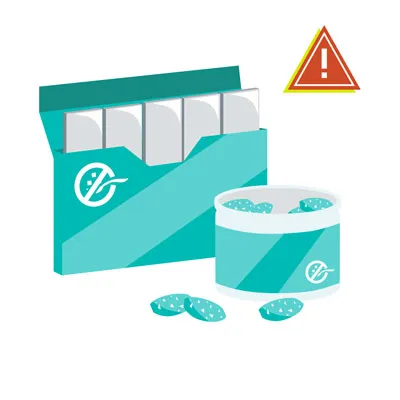 A scattering of sugar-free gum sticks and hard candies
A scattering of sugar-free gum sticks and hard candies
17. Tomatoes and Raw Potatoes
Tomatoes and potatoes fall into a category of foods that are safe in some forms but unsafe in others. A ripened red tomato is generally acceptable, however, the green parts of the tomato plant, and green, unripe tomatoes, contain solanine, which is toxic to dogs. Raw potatoes also contain solanine, making them toxic. Baked or boiled potatoes without additives are generally safe in small amounts.
18. Tobacco
Tobacco and any nicotine-containing products are dangerous and unhealthy for your dog. Exposure can cause a range of symptoms, including vomiting, diarrhea, rapid breathing, agitation, abnormal heart rate, wobbliness, muscle weakness, fluctuations in blood pressure, seizures, and tremors. More frequent or significant exposure can lead to blue gums, coma, and ultimately be fatal. Dogs are naturally curious and might encounter cigarettes left on the sidewalk or butts in an ashtray. If your dog gets into tobacco, immediate veterinary attention is crucial.
19. Yeast and Raw Dough
Yeast and raw dough are unsafe for dogs for several critical reasons. The raw dough can expand significantly in a dog’s stomach, causing severe pain and potentially life-threatening conditions like gastric torsion or rupture. Additionally, the yeast and sugar in raw dough can ferment, producing alcohol and leading to alcohol toxicity, which can quickly become fatal and requires immediate medical intervention.
20. Raw Meat
Never feed your dog raw or undercooked meat. Raw meat can harbor harmful bacteria like Salmonella or E. coli, which can sicken dogs just as they can humans. Furthermore, bones in raw meat pose a significant choking hazard and can cause internal injuries.
21. Rhubarb
Rhubarb, often used in desserts, is not safe for pets. Its leaves contain soluble calcium oxalate crystals. Consumed in large enough quantities, these crystals can bind with calcium in the body, leading to a dangerous drop in calcium levels and potentially renal failure. Symptoms include tremors, weakness, drooling, bloody urine, changes in thirst and urination, and vomiting.
22. Star Fruit
Similar to rhubarb, star fruit also contains soluble calcium oxalate crystals. Do not allow your dog to snack on this fruit.
23. Flavored Water and Seltzer Water
When it comes to beverages for your dog, it’s always best to err on the side of caution and provide fresh, clean plain water. Flavored and carbonated waters can contain added ingredients that are dangerous for pups, such as sugar or salt. While plain seltzer water might be acceptable in small, urgent situations, it can cause gas and bloating. Sticking to plain water is the safest option.
13 Foods Safe for Dogs
While the list of what food dogs cannot eat is substantial, there’s also an extensive list of safe and healthy foods your dog can enjoy! Some popular and healthy choices include small amounts of dehydrated chicken or beef, apples (without the core), green beans, and carrots.
Here are some commonly enjoyed foods that your dog can safely eat. This list is not exhaustive but provides a great starting point. For more options, explore our article on what fresh vegetables are good for dogs.
1. Apples, Oranges, and Bananas
Remember to remove apple cores and seeds due to their toxicity, but the fleshy parts of apples are perfectly fine. Slice them into small pieces to prevent choking. Oranges are safe in small quantities. Bananas (peeled) can also be a tasty treat in moderation.
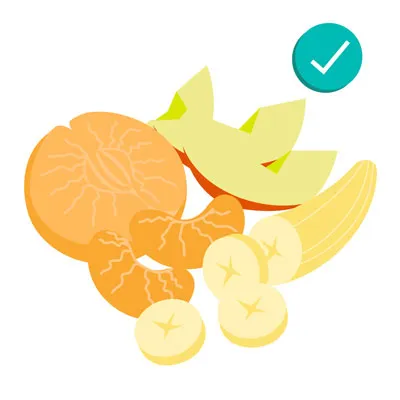 A colorful assortment of fresh fruits including apples, oranges, and bananas
A colorful assortment of fresh fruits including apples, oranges, and bananas
2. Blueberries and Blackberries
Blueberries are a delightful and healthy treat that most dogs love. They are packed with antioxidants, fiber, phytochemicals, and vitamin C, all beneficial for your pup’s health. Blackberries offer similar benefits and can also be given in moderation.
3. Cantaloupe, Mango, Peaches, Pears, Pineapples, and Watermelons
Many fruits can be safely enjoyed by your dog, so feel free to offer a variety to discover their favorites! Cantaloupe is an excellent choice. Watermelon is also a hit, especially on warm days, but always remove the rind and seeds (including the pale seeds in seedless varieties) to prevent choking. Mangoes, peaches, pears, and pineapples are also safe in moderation. Always ensure seeds, pits, and cores are removed before serving these fruity treats.
4. Carrots, Cucumber, and Celery
Looking for more healthy ideas? The “three C’s”—carrots, cucumbers, and celery—are fantastic options, especially for overweight dogs, as they are very low in calories. Bite-sized carrot pieces provide a satisfying crunch that many dogs adore. Celery bites also offer a fun crunch and can help with bad breath. Cucumber slices are rich in vitamins and minerals, with minimal carbohydrates or fats.
5. Cheese
While generally, milk and dairy products should be approached cautiously, a small amount of cheese occasionally is acceptable if your dog is not lactose intolerant. Opt for lower-fat varieties, such as a little mozzarella, as some cheeses are high in fat, which can be problematic for dogs.
6. Eggs
Fully cooked eggs can be a delicious and beneficial treat for your dog. Scrambled eggs, in particular, can help soothe an upset stomach and provide an excellent source of protein.
7. Peanuts, Peanut Butter, and Cashews
Peanuts and cashews are safe for dogs when given in small quantities. However, due to their high-fat content, they should be offered sparingly. Ensure they are unsalted, unflavored, and unspiced. Peanut butter, in moderation, is a popular, high-protein treat for pups. Always choose unsalted peanut butter and meticulously check labels to ensure it contains no xylitol.
8. Popcorn and Corn
Popcorn can be a tasty treat for your dog. Choose air-popped, unsalted, and unbuttered popcorn. Carefully inspect the popcorn to ensure there are no unpopped kernels, which could cause choking. Corn (removed from the cob) is also acceptable when served without butter, salt, or spices.
9. Coconut and Honey
In small amounts, coconut (including coconut milk and coconut oil) is generally fine for your dog. It contains lauric acid and may even help with allergies. However, some dogs might experience stomach upset from fresh coconut or coconut milk, so introduce it cautiously. Avoid coconut water, which is not safe, and never let your dog eat the furry shell, which poses a choking hazard. Honey, in moderation, is also safe and offers beneficial vitamins and minerals.
10. Shrimp and Fish
Plain, fully cooked shrimp is a healthy choice for your dog. Always remove the shell, head, tail, and legs, and avoid any seasoned, salted, or buttered preparations. Fish, especially salmon and sardines, is also permissible. Ensure it is plain, fully cooked, and boneless. A good guideline is to offer fish no more than twice a week. Plain, canned tuna, packed in water (not oil), is safe in moderation to prevent excessive mercury and salt intake.
11. Turkey
Turkey meat, once the skin, fat, and bones are removed, is a healthy and safe source of protein for dogs. Offer small, plain bites as a delicious treat, avoiding any seasoned or salted preparations.
12. Grains, Wheat, and Quinoa
Grains, wheat, and quinoa can be part of a dog’s diet. Small amounts of wheat or other grains are generally fine, and quinoa is a nutritious filler option. Always monitor your dog for any signs of allergic reactions. For more ideas on safe and healthy ingredients, check out our guide on what can puppies eat other than dog food.
13. Green Beans
Many dogs enjoy green beans, whether served raw, steamed, or from a can. They are safe, tasty, and healthy—a great combination. Opt for raw or plainly cooked green beans without added spices, oils, or salt. Cut them into small, bite-sized pieces to prevent choking.
What Dogs Are Most at Risk if They Consume Toxic Foods?
While all dogs should be protected from toxic foods, certain individuals are at a higher risk of severe reactions:
- Small breeds vs. large breeds: Smaller dogs are more vulnerable due to their lower body weight, making substances like chocolate particularly dangerous for them.
- Puppies: Younger dogs have less developed digestive and immune systems, increasing their risk from certain substances.
- Elderly dogs: Older dogs may face higher risks due to underlying health conditions.
- Dogs with pre-existing conditions: Conditions such as diabetes or kidney disease can significantly increase a dog’s vulnerability to toxic foods.
How To Prevent Dogs from Eating Toxic Foods
While accidents can happen, proactive measures can significantly minimize the risk of your beloved pup ingesting unsafe human food. This commitment to prevention is a cornerstone of responsible pet ownership. If you’re wondering what you absolutely shouldn’t feed your dog, our article on what shouldnt i feed my dog provides even more specific warnings.
1. Store Foods Out of Reach
Ensure that all toxic foods are completely inaccessible to your dog. Keep dangerous items on high shelves, in securely latched cabinets, or in pantries that your pup cannot open.
2. Avoid Feeding Dogs from Your Plate
Resist the urge to feed your dog from your plate or while you are cooking in the kitchen, even if it’s just a tiny treat. It is safest to only provide treats that are specifically formulated and approved for dogs.
3. Educate Family Members and Guests
Make sure everyone in your household, including children, and any guests are aware of the rules regarding feeding your dog. Emphasize that no matter how tempting it may be, they should never sneak any human food to your pet without your explicit approval.
4. Be Careful During Holidays
Exercise extra caution during holidays and festive periods. The increased hustle and bustle of these times can make it easy to let your guard down, especially when there’s an abundance of human food around. Always have emergency contact information readily available for 24/7 veterinary services or poison control hotlines. For more ideas on how to safely share human food with your dog, check out what is the best human food to feed your dog.
What To Do if Your Dog Eats Something Toxic
If, despite your best efforts, your dog consumes something toxic, swift action is crucial.
Familiarize yourself with the symptoms of food toxicity so you can quickly recognize when your dog is in distress. These symptoms vary depending on what was ingested and can include listlessness, pain, distress, vomiting, bloody stools, or a bloated, hard-to-the-touch stomach. A severely bloated stomach can indicate a life-threatening condition that, if untreated, could lead to rupture.
If you observe any of these symptoms, take the following steps:
- Call your veterinarian or poison control immediately. Time is of the essence; treatments are generally more successful and hospitalization shorter when a dog receives prompt medical attention.
- Be prepared with all relevant information. This includes the type of food eaten, the estimated amount consumed, and the time of ingestion.
- Avoid home remedies unless advised by your veterinarian. Remedies can vary based on the toxin, and even inducing vomiting can be harmful in certain situations.
Keep Your Dog Safe and Healthy
Navigating the world of human foods can be challenging, especially with the numerous household toxins and dangerous foods your dog might encounter. Dogs aren’t always discerning eaters, sometimes even consuming their own waste! However, by diligently following this guide and remaining vigilant, you can significantly protect your dog from harmful foods.
The good news is that a wide array of safe and healthy foods are available for your dog to enjoy. Discover which ones on our safe list your dog loves and offer them as well-deserved treats. If you are ever uncertain about a particular food, always consult your veterinarian for expert advice.
Pet insurance can also offer a vital layer of protection against unexpected encounters with toxins. Many plans provide access to 24/7 veterinary helplines, which can be invaluable when you are worried about something your pet may have eaten. This ensures you always have expert guidance at your fingertips.
Sources/ Citations
- “Top 10 dog poisons,” Hilary Parker (5/2023), WebMD, https://www.webmd.com/pets/dogs/top-10-dog-poisons
- “What happens if a dog eats chocolate?” (10/2023), Colorado State University, https://vetmedbiosci.colostate.edu/vth/animal-health/why-is-chocolate-bad-for-dogs/
- “Fruits and vegetables dogs can or can’t eat,” (3/2024), American Kennel Club, https://www.akc.org/expert-advice/nutrition/fruits-vegetables-dogs-can-and-cant-eat/
- “What to do if your dog drinks alcohol,” Jerry Klein (7/2023), American Kennel Club, https://www.akc.org/expert-advice/vets-corner/is-alcohol-dangerous-for-dogs/
- “Can dogs eat apples?” Hector Joy (12/2022), PetMD, https://www.petmd.com/dog/general-health/can-dogs-eat-apples
- “Can dogs eat plums?” Katie Koschalk (7/2023), Chewy, https://be.chewy.com/nutrition-pet-diet-tips-can-dogs-eat-plums/
- “Avocado (Persea spp) Toxicosis in Animals,” Cristine Hayes (9/2024), Merck Veterinary Manual, https://www.merckvetmanual.com/toxicology/food-hazards/avocado-persea-spp-toxicosis-in-animals
- “People foods to avoid feeding your pets,” (n.d.), ASPCA, https://www.aspca.org/pet-care/animal-poison-control/people-foods-avoid-feeding-your-pets
- “People foods dogs can and can’t eat,” (3/2024), American Kennel Club, https://www.akc.org/expert-advice/nutrition/human-foods-dogs-can-and-cant-eat/
- “Can dogs eat nuts?” Amanda Ardente (1/2023), PetMD, https://www.petmd.com/dog/nutrition/can-dogs-eat-nuts
- “Can dogs drink milk?” Sandra C. Mitchell (1/2024), PetMD, https://www.petmd.com/dog/nutrition/can-dogs-drink-milk
- “Can dogs have nutmeg?” Barri J. Morrison (11/2023), PetMD, https://www.petmd.com/nutmeg-safe-dogs
- “Onion, garlic, chive, and leek poisoning in dogs,” Renee Schmid et al. (2024), VCA Animal Hospitals, https://vcahospitals.com/know-your-pet/onion-garlic-chive-and-leek-toxicity-in-dogs
- “Can dogs eat tomatoes?” Anna Burke (10/2024), American Kennel Club, https://www.akc.org/expert-advice/nutrition/can-dogs-eat-tomatoes/
- “Can dogs eat potatoes?” Katherine Ripley (11/2023), American Kennel Club, https://www.akc.org/expert-advice/nutrition/can-dogs-eat-potatoes/
- “What to do if your dog eats a cigarette butt,” (6/2023), American Kennel Club, https://www.akc.org/expert-advice/health/dog-ate-cigarette-butt/
- “Dough & dogs: Why it’s bad and what you can do,” Lisa Goldstein (7/2024), Preventive Vet, https://www.preventivevet.com/dogs/dough-is-toxic-to-dogs
- “Rhubarb,” (n.d.), Pet Poison Helpline, https://www.petpoisonhelpline.com/poison/rhubarb/
- “Can dogs drink carbonated water?” Heather Logue (n.d.), Rover, https://www.rover.com/blog/can-dogs-drink-carbonated-water/
- “What fruits can dogs eat?” Ellen Malmanger (2/2024), PetMD, https://www.petmd.com/dog/nutrition/what-fruits-can-dogs-eat
- “Can dogs have green beans?” Anna Burke (8/2022), American Kennel Club, https://www.akc.org/expert-advice/nutrition/can-dogs-have-green-beans/
- “About pet food safety,” (4/2024), CDC, https://www.cdc.gov/healthy-pets/about/pet-food-safety.html
